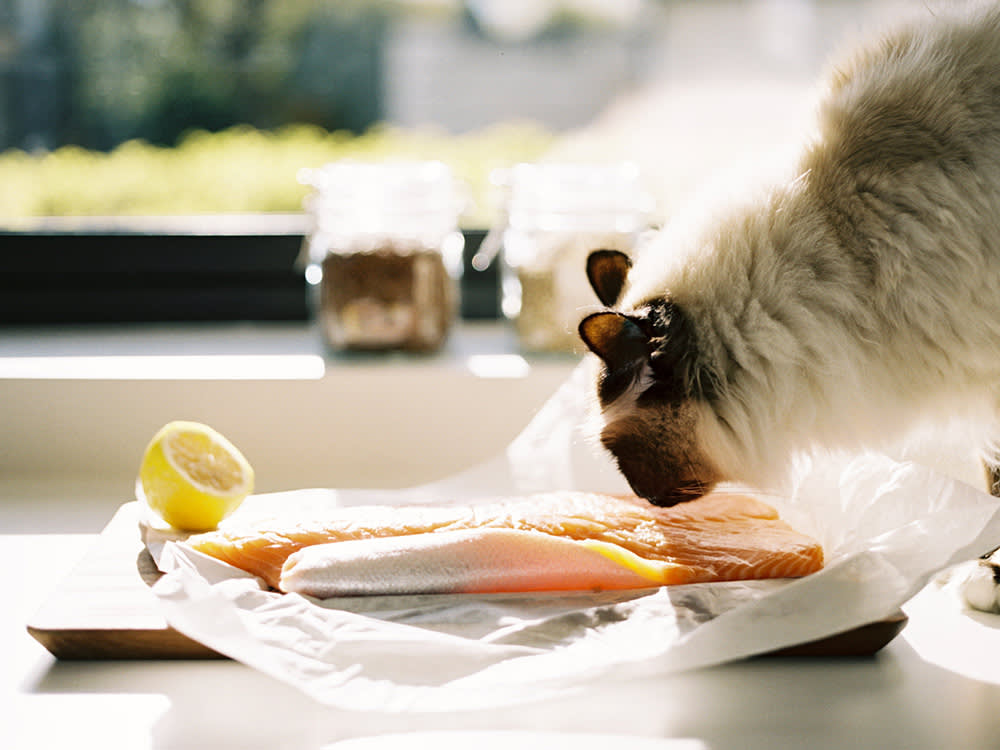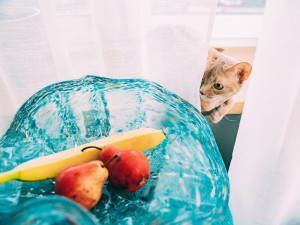Can Cats Eat Tuna?
It’s a classic kitty snack, but don’t go overboard.

Share Article
Do you have a cat who comes running at the sound of a tuna can popping open, tries to steal the sushi right off your chopsticks, or even dips their paws into the fish tank trying to snag a snack? So many cats love fish, which is ironic, because they evolved from desert animals who probably never encountered a single fish. And yet, scientists have discovered consistent evidence that many cats have a preference for fishopens in new tab flavors programmed into their taste buds.
While it is fairly indisputable that many cats would choose fish any time of day or night, is it really safe to feed your cat fish, especially tuna? The answer is that fish (including tuna) is safe in small amounts and provides some great health benefits to cats. But there are important caveats to note when introducing fish into your cat’s diet. Above all else, it is most important to ensure your cat’s main diet is a complete and balanced cat food and that any treats or snacks are kept to a minimum. Read on to learn more about cats and tuna.
Nutrition facts about tuna for cats
There are many health benefits of eating fish that apply to both humans and animals. Proponents of mediterranean-style dietsopens in new tab include fish as a good source of lean protein as well as essential fatty acids, which promote heart health and reduce inflammation. Cats also benefit from these properties and more including:
Protein: Cats are obligate carnivores and have high protein requirements in their diet. They need to get certain nutrients from animal-derived sources and cannot meet all of their needs on a vegetarian diet. Fish provides a good source of lean protein comprised of essential amino acids that cats need for many basic biological functions.
Fat: Cats use fat as a good source of energy for daily activity. It also makes their food taste better to them, and helps them feel satisfied sooner when their meal has adequate fat content. Fish like tuna are especially high in omega-3 fatty acids, including EPA and DHA, which are important for normal brain development, heart and blood vessel function, and in reducing inflammation throughout the body.
Vitamin D: While humans and other animals can synthesize vitamin D from exposure to sunlight, cats cannot do this and must obtain vitamin D from their food. They utilize vitamin D3 most effectively, and this comes mostly from animal sources, such as fatty fish and meat.
Is tuna good for cats?
Tuna and other fatty fish are good for cats in small amounts; however, there are also some risks to be aware of. Fish alone is not a complete and balanced diet and cats who only eat fish will develop serious nutritional deficiencies that can be life-threatening. As an occasional snack or treat, tuna is safe and can provide a boost of healthy nutrients. All treats and table scraps should be limited to less than 10 percent of a cat’s total diet to ensure they get most of their calories from a balanced diet.

Cat food diets that are fish-flavored are also safe and healthy for the most part. Some veterinarians recommend introducing cats to other flavors first because they might become so hooked on fish-flavored varieties that they’ll reject other flavors.
Later, if they need a diet change or prescription diet due to a health problem, it can be difficult to introduce other flavors. Encouraging your cat to eat a greater variety of flavors can help prevent that finickiness later on. Also, saving fish-flavored cat foods for those desperate times when your cat needs to take medication, or they have a poor appetite can give you an extra yummy tool in reserve to tempt your cat to eat.
Can cats eat any part of the tuna?
In addition to only offering small amounts of tuna as a snack, it’s also important to think about what kinds of tuna are safe for cats to snack on. Raw fish and fish containing skin and/or bones should be avoided. These can increase the risk of certain health hazards. Small amounts of canned tuna, especially canned light tuna packed in water, are a safe choice, as is cooked tuna that has no skin or bones in it.
Is tuna completely safe for cats?
Tuna is not completely safe for cats and like many foods, it all comes down to moderation and doing your research. There are important factors to keep in mind if you are considering sharing some tuna with your cat including:
Mercury content: Tuna is a fatty fish towards the top of the food chain, which means certain heavy metals accumulate in these large fish as they eat smaller prey with trace amounts of contaminants. Mercury toxicity can cause serious neurological problems. Different sourcesopens in new tab of tuna have different levels of mercury, with canned light tuna having much lower levels of mercury compared to Yellowfin and Ahi tuna which have the highest levels. A small snack of tuna on occasion would not put a cat at risk for mercury poisoning; however, cats who eat tuna daily could be at risk for this.
Thiamine deficiency: Raw tuna contains an enzyme called thiaminase, which inactivates thiamine, an essential vitamin also known as vitamin B1. Cats who eat large amounts of raw fish like tuna can develop thiamine deficiency as a result. This can lead to weight loss, weakness, and heart failure. The thiaminase enzyme is deactivated when the fish is cooked, and is also not a concern when only small amounts of fish are eaten on occasion.
Choking hazards: When offering your cat a treat or table scrap, be sure to offer it in a form that is safe and easy for them to chew and swallow. Large pieces of whole fish can pose choking hazards, especially if they contain bones or large pieces of tough skin. These materials can also cause digestive upset including vomiting and/or diarrhea. Always offer your cat small bite-sized pieces of fish with the bones and skin removed.
Other ingredients: This is a good reminder that other ingredients we cook with and/or eat may be toxic to cats. Be sure to double-check the ingredients in anything you offer to your cat to confirm that it is safe. Skip feeding your cat fish that may have been cooked with garlic, onions, lots of salt, or other ingredients that could be unhealthy for your cat.
The bottom line: Can cats eat human food?
Cats can eat certain human foods, and it can be fun to share the occasional snack with them. This not only provides a great opportunity for bonding, but provides enrichment through new experiences and flavors. It’s always important to do your research first to make sure the food you are providing is safe and non-toxic to cats. Start with a very small amount of the new food and be sure to monitor your cat for any signs of adverse reaction such as gagging, vomiting, diarrhea, and/or swelling of the face.
Snacks and treats should be minimized to ensure your cat eats enough of their primary diet to get all of the unique nutrients they really need. There are also many human foods that are unfortunately toxic to cats, so be sure to consult your veterinarian or a pet-poison hotline if you have any questions about what foods are safe for cats.
Other human foods that are safe for cats
Bananas can be a tasty snack to share with your cat in moderation
Ham with low-sodium can also be a special treat
Corn is also OK in small amounts, but watch out for the sugars and carbs
Other human foods that are dangerous for cats
Garlic can cause a life-threatening anemia in cats
Cheese can be risky to share with your cat, so be sure to do your research
Chocolate’s main ingredients, methylxanthines and caffeine, are toxic to cats
FAQs (People also ask):
Can cats eat tuna?
Cats can eat small amounts of tuna as a snack or treat. Tuna alone is not a balanced diet and can cause serious nutritional deficiencies if it’s the only thing they eat.
How much tuna can a cat eat?
Tuna and other treats or table scraps should be limited to less than 10 percent of a cat’s total diet, and it should only be offered occasionally, not daily.
Is tuna safe for cats?
Tuna is safe for cats in small amounts. The safest way to offer it is as plain, cooked tuna meat with no skin or bones.
Is it OK to give cats tuna?
It is okay to give cats small amounts of tuna as a treat. It should not be their main diet unless it is a fish-based commercial cat food diet that is complete and balanced.
Why do cats like tuna?
Cats have taste buds that pick up certain flavors unique to fish and make it especially appealing. It also has a strong smell that many cats love.
Can cats eat tuna skin?
Tuna skin can be tough to chew and digest, putting them at risk for choking and/or digestive problems. It’s best to avoid feeding them the fish skin.
References:

Dr. Amy Fox, DVM
Amy Fox, DVM is a small animal veterinarian in New York City with over thirteen years of experience in a mixture of general practice, emergency medicine, and shelter medicine. A lifelong animal lover, Dr. Fox studied biology in college and then worked as a veterinary nurse before pursuing veterinary school at Cornell University. Her expertise includes surgery, dentistry, and management of chronic conditions, and she is interested in toxicology, pain management, nutrition, care of senior pets, and educational outreach. Dr. Fox also enjoys writing about veterinary medicine and teaching, and her work has previously appeared in Spruce Pets. In her free time, she loves to cook, garden, go for long runs, and hang out with her goofy mixed-breed dog May, who provides never ending comic relief!
Related articles
![Woman feeding her puffy cat at the table.]()
What Human Foods Can Cats Eat?
We know they’re begging—but what’s safe to share?
Can Cats Eat Carrots?
Learn whether your little Bugs Bunny can crunch on the veggie.
![a cat stares at green grapes on a plate]()
Can Cats Eat Grapes?
This is one you’ll want to bookmark.
![A brown cat with a snake plant.]()
Are Snake Plants Toxic to Cats?
All you need to know about snake plants — plus, other plants that are toxic (and safe).
![Cat playing in spider plant.]()
Are Spider Plants Toxic to Cats?
Learn what you should do if your “spider babies” and cat baby interact.
![Dark grey cat eating two slices of break laid on top of a wooden railing of an outdoor deck]()
Can Cats Eat Bread?
Go ahead and give your carb-loving cat a few bites, but don’t hand over the bread basket.










